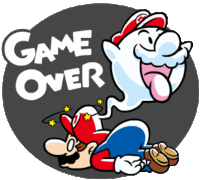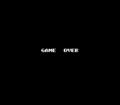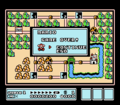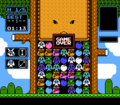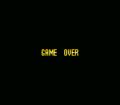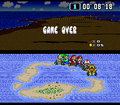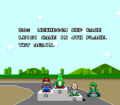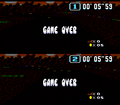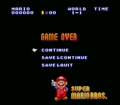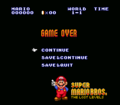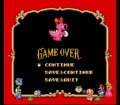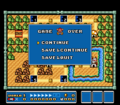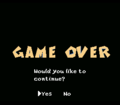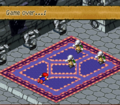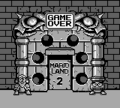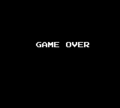Game Over
Game Over is a common term used in the Mario franchise and most other video games that is given to the player when they run out of lives/chances. Usually, they cannot continue and must restart the game, but can still often load their progress. In few cases, they cannot load any progress at all and a Game Over can be more of a big deal than in other games; this usually applies to games lacking save features, a subtype that usually consists of games from older hardware generations.
The game over screen differs from game to game, but the text is usually against a black screen and playing background music with a sad tone that seems to mock the player.
There also exist non-standard game overs, which involve special punishments for specific mistakes.
"Game Over" as death
- “Peach... Noble princess, pure of heart... Do you take Bowser to be your lawfully wedded husband 'til your game be over?”
- —Count Bleck, Super Paper Mario
As referenced throughout Super Paper Mario, a Game Over for Mario franchise characters is their equivalent of death, as extra lives make mere "death" a mild hiccup.[1]
In that game, Dimentio sends Mario and his teammates to "the next world", albeit "while still very much alive",[2] which is similar to the philosophy of the afterlife. Mario, Luigi, and Bowser end up in The Underwhere which resembles Hell, where some Shaydes ask Mario how his "game", referring to his life, was. Also, many Shaydes can be seen discussing how they got a Game Over. The Overthere resembles Heaven, surrounded by clouds, sun, and rainbows. Princess Peach ends up there.
That said, all the conversations in the The Underwhere seem to suggest that Shaydes can request an audience with Queen Jaydes who will weigh in their sins and send them to The Overthere, submit them to punishments befitting of their crimes or even return them to the land of the playing if the situation calls it.
It is never clearly shown the areas of The Underwhere or The Overthere where Jaydes sends the dead people; all that are seen in The Underwhere are Shaydes that have not yet requested an audience with Jaydes, and D-Men who work for her, while all that are seen in The Overthere are Nimbis (and Skellobits that are invading). It is implied that the dead villains are condemned to an area below The Underwhere, where Bonechill was also imprisoned before he escaped. It is possible that the paradise dimension witnessed at the end credits may be an area of The Overthere, though what Nastasia says seems to suggest otherwise.[3]
One Shayde speculates that if a dead person dies in the Underwhere or Overthere, their aftergame ends and they go to a "post-aftergame".
When Count Bleck was using The Void to destroy all worlds, The Void also appeared in the Overthere, indicating that it would even destroy the aftergame. Where all the dead characters (or even all the characters altogether) would have gone following the aftergame's destruction is unknown; however, a young Flip-Flop girl speculates that the souls of the deceased would be forced to drift aimlessly in the empty white space left behind by The Void due to being left without a world or aftergame to reside in, a fate deemed both sad and boring.
Aside from Bowser (who appears to have infinite lives, as seen in Paper Mario: The Thousand-Year Door, though his death in New Super Mario Bros. seems to be the exception, as he has to be revived by Bowser Jr. from his bones), several enemies have appeared to return from the dead. The most infamous is Petey Piranha, who dies after each battle, yet often returns for another game. King Boo was apparently destroyed in Super Mario Sunshine, yet returned in Super Princess Peach. Also, the Koopalings were seemingly killed in their respective battles in Super Mario World (either falling into the lava or vanishing in a puff of smoke before their castle blows up), yet they returned in Mario & Luigi: Superstar Saga, New Super Mario Bros. Wii and New Super Mario Bros. U.
In Super Smash Bros. Brawl, if Solid Snake starts a Codec Conversation on Pit, he will say "And by trials, you mean, 'Game Overs'?"
Notable "Game Over" screens
Super Mario series
In Super Mario Bros. when the player runs out of lives, the level turns into a black background with the words "GAME OVER", while the HUD is still present. If the player times out on their last life, "TIME UP" appears first while the Game Over music plays.
In Super Mario Bros.: The Lost Levels, the game over screen has GAME OVER, as well as the choices "CONTINUE" and "RETRY", which has the player either restart the specific level they died on, or otherwise restart the game. If the player runs out of lives in World 9, the Game Over screen looks different. Instead of the usual choices "CONTINUE" and "RETRY", there is a message that reads: "YOU'RE A SUPER PLAYER! WE HOPE WE'LL SEE YOU AGAIN. MARIO AND STAFF."
In Super Mario Bros. 2, the Game Over screen just depicts the words "GAME OVER" in a black background. After the Game Over music has played, the text changes into two choices, reading "CONTINUE" and "RETRY". If the player chooses "CONTINUE", the game will resume, but if the player chooses "RETRY", the game will return to the title screen. Also, in the NES version the player can only use two continues (this is depicted by the amount of continues remaining on the Continue screen), the third Game Over will only show "RETRY" on the screen after the Game Over music has played. In all other versions the player has an unlimited amount of continues - also, the player can save the game with two choices replacing "RETRY": "SAVE & CONTINUE" and "SAVE & QUIT".
In Super Mario Bros. 3, receiving a Game Over will return the player to the map, while a light blue rectangle appears with the words "Game Over", with a "dead" Mario or Luigi to the left of the two choices "CONTINUE" and "END".
In Super Mario Land, all enemies disappear and the "GAME OVER" appears from the bottom of the screen. If the player got 100,000 points or more upon receiving a Game Over, they can use a "Continue" to play the level again to where they got the Game Over. In Super Mario Land 2: 6 Golden Coins, a Game Over sign appears at the top of the screen and the player would lose all the Gold Coins they earned in the game. After waiting for two minutes, "Totaka's Song", a common Easter Egg found in video games involving Kazumi Totaka, will start to play. In Wario Land: Super Mario Land 3, they would lose one of their treasure, or half their cash if they did not have any treasure.
In Super Mario All-Stars, a Game Over means the player will restart from the world they lost in (however in the Lost Levels version of the game a Game Over means the player will only restart the level they were playing). Regardless of which game is being played, the player has unlimited continues and 3 choices: "CONTINUE", "SAVE & CONTINUE" & "SAVE & QUIT" (the only exception is when one player gets a game over in 2-player mode, in which only 2 choices are present: "CONTINUE" and "QUIT", the latter choice dropping them out for the remainder of the session). In Super Mario Bros. and Super Mario Bros.: The Lost Levels, a Game Over sign appears at the top of the screen (in 2-player mode, the character who got the Game Over also appears). In Super Mario Bros. 2, a Game Over sign appears with Birdo in it, with the design similar to the title screen. This same screen also appeared for warping, but it instead said "WARP" and the world number that the player is going to. If played in Super Mario Bros. 3, the Game Over screen shows a blue rectangle box with a "dead" Mario or Luigi in between the "Game Over" words.
The Super Mario Advance series basically shares the same screens as the original games (in case of 2 and 3) and the All-Stars games (in case of 1 and 4). However, the first game shows the player's world and score when they received the Game Over, pressing ![]() gives them the same options as in the All-Stars game. Unlike the NES and SNES versions, this game restarts the level of which the player was playing on in case of a game over. The second game did not return the player to the title screen in a Game Over, regardless if the player saved or not. The third game appeared to function the same way as the original. The fourth game displayed a yellow GAME OVER sign between the "dead" Mario on a black screen before the usual screen appears on the map. However only two choices are given: "CONTINUE" and "QUIT" (though the levels that were cleared won't be set back to incomplete).
gives them the same options as in the All-Stars game. Unlike the NES and SNES versions, this game restarts the level of which the player was playing on in case of a game over. The second game did not return the player to the title screen in a Game Over, regardless if the player saved or not. The third game appeared to function the same way as the original. The fourth game displayed a yellow GAME OVER sign between the "dead" Mario on a black screen before the usual screen appears on the map. However only two choices are given: "CONTINUE" and "QUIT" (though the levels that were cleared won't be set back to incomplete).
In Super Mario 64, when Mario gets a Game Over, the player will return to the title screen, except the background is red and reads "Game Over". A piece of Bob-omb Battlefield music plays, slowly decreasing in pitch, and Mario's face looks worn out. The main menu music then plays and rises back to its normal pitch. In Super Mario 64 DS, Mario's face doesn't appear. Also, the background is a dark gray gradient instead of red and without text reading "Game Over". instead, the purple words "GAME OVER" reads in the middle of the screen, in the same font as the title uses.
In Super Mario Sunshine, the Game Over sign follows the "Too Bad!" sign if Mario loses his last life with a small animation (in translated versions, the "Too Bad!" sign says "Arrivederci", Italian for "goodbye". In the Japanese version, however, it says "Miss!" instead). The Game Over sign is red. Following the Game Over, the player is asked if (s)he could either continue from the last save point or return to the title screen. Continuing would result in Mario abruptly returning to Delfino Plaza with his life-counter reset to 3.
Super Mario Galaxy and Super Mario Galaxy 2 almost shares the same Game Over look with Super Mario Sunshine; if Mario/Luigi loses his last life, the Game Over sign shows instead of the "Too Bad!" sign (In the Japanese version, however, the "Too Bad!" sign is "Miss!" instead). There is an exception: if a player gets a Game Over because of losing to Cosmic Mario, the "You Lose" message appears as usual before the Game Over sign appears. The Game Over sign is purple in Super Mario Galaxy and yellow in Super Mario Galaxy 2.
In New Super Mario Bros., the Game Over sign appears in blue and drops from the top of the screen, with the word "Over" appearing first. After the music has played, they will be given an option to Continue or Quit. This is the only game in the New Super Mario Bros. series that has a unique Game Over fanfare, as the other three games share the same fanfare. New Super Mario Bros. 2 appears to have the same concept, except that the Game Over sign drops down one letter at a time starting with "G", colored in red.
In New Super Mario Bros. Wii and New Super Mario Bros. U the Game Over screen appears before the continue screen. In the former game, the words GAME OVER! drop from below in a puff of smoke, while in the latter game, the words GAME OVER appear in purple. In multiplayer on both games, if some (but not all) players get a Game Over, the GAME OVER sign does not appear, instead the Continue screen appears after returning to the World Map but before selecting a level (in the case of the former game), or before returning to the World Map (in the case of the latter game). In the latter game, a GAME OVER sign also appears if the player fails Boost Rush. In the former game, Mario gets depressed when a Game Over is received and says "Here we go again!" when he uses a Continue. The same applies to the other three characters but only when they use a continue (Luigi says "I'm a-back!", Blue Toad makes a sound similar to winning a minigame in Mario Party 6 with the lack of "I am the winner!", and Yellow Toad makes a strange sound).
In Super Mario 3D Land, there is a yellow background, and Mario or Luigi falls onto the ground, depressed, and a red Game Over sign appears. If the player selects "Quit" on the Touch Screen, Mario or Luigi will become even more depressed and the game progress will be saved, but if the player selects "Continue", Mario or Luigi will happily run away. After this, he will go to the Hint Room, with a special power-up and a Toad explaining a basic use of the power-up to Mario, but only in the normal worlds. Super Mario 3D World also has the same game over screen and concept except it has a red background with a brown Game Over sign and when the player picks "Continue", all Toad Houses and Lucky Houses will be reopened.
In Super Mario Maker, if the player loses all of their lives in either the 10 Mario or 100 Mario Challenges, the Game Over screen will appear, depicting a black screen with Mario's death sprite in the middle, which drops down from the top of the screen with the letters of the "GAME OVER" words also dropping into place above, written in purple. Both the music and Mario's sprite are taken from Super Mario Bros., regardless of what game theme the current level was using when the player lost their last life. The hidden Gnat Attack minigame also has its own Game Over screen if the player runs out of time; the HUD and all enemies disappear while the same letters of the "GAME OVER" words should drop into place. The player is then given a option to retry or quit.
Paper Mario series
In Paper Mario and Paper Mario: The Thousand-Year Door, the Game Over screen depicts Mario lying dead (or having Mario's hiding his eyes with his cap) under a spotlight with the orange words GAME OVER while the classic Mario series Game Over theme plays. The first game returned the player to the title screen upon receiving a game over. In addition, the latter is one of the first Mario games to feature non-standard Game Overs with five total (for example, getting crushed by the spiked ceiling in Hooktail's castle or reading Ghost T.'s diary in The Thousand-Year Door). In Super Paper Mario, the music and the words remain, but the fallen Mario is not present. It retains the non-standard ways to get Game Overs; for example, refusing to answer either Merlon's pleas for help at the beginning of the game (before the player even first takes control of Mario) or Tippi's request to wear a helmet in Outer Space will result in a Game Over. In Paper Mario: Sticker Star, it has a similar concept as Paper Mario and Paper Mario: The Thousand-Year Door, but the spotlight and text are purple and a different tune is present. There is a way to get a Game Over which is letting the Big Cheep Cheep explode on Mario without a Spike Helmet. In Paper Mario: Color Splash when Mario is defeated, six Slurp Guys will come in and drain all of his color, which results in a Game Over. Other ways to get it during the game include falling in lava at the Kiwano Temple, getting his bubble popped by the Big Urchin during Snifit or Whiffit, getting crushed by Princess in Marmalade Valley, and more. If Mario is defeated by a Koopaling's special move without the Thing required to beat them, Huey will appear on the Game Over screen and tell the player to ask the Know-It-All Toad in Port Prisma for guidance.
Luigi's Mansion series
In Luigi's Mansion and Luigi's Mansion: Dark Moon, when a game over occurs, instead of the usual game over sign, the text will read "Good night!" as if Luigi has fainted and/or fell asleep. In the first game, when a game over occurs, the player will be taken back to the title screen, but in the sequel, the player is asked if they will restart to the beginning of the mission or return to the Bunker; however, in ScareScraper, when the player(s) fail(s) a floor, a game over occurs, but it will read "Game Over" instead of the usual "Good night!". If playing local or download play, the host (player) will be asked if they can play again. The Luigi's Mansion beta's Game Over is the same as the final, only difference is that there's no music.
Donkey Kong series
In Donkey Kong Country, the game over shows a screen of Donkey Kong and Diddy Kong in bandages in a black background with depressing music and a deranged text font.[4] This carries over to its GBC and GBA ports, although with slight modifications each time. The Game Over screen in the GBC port plays a different music – a slowed down version of part of the "DK Island Swing" theme.[5] The same screen in the GBA version had its dark background changed to an aerial view of a jungle.[6]
In Donkey Kong Country 2: Diddy's Kong Quest, the Game Over screen consists of Diddy Kong and Dixie Kong appearing tied to each other in a black cell, with Diddy having a scared face looking out the window and Dixie having a depressed face looking away. The screen then turns to a red tint.[7] The background image can also be seen in error and antipiracy screens in the game. The game over screen had been carried over to the game's GBA port.[8]
In Donkey Kong Country 3: Dixie Kong's Double Trouble, the Game Over screen consists of an image of Dixie Kong and Kiddy Kong inside a crib within a dark room. Kiddy is in closeup while Dixie lies behind, both of them dispalying saddened expressions. On the bottom of the picture, the phrase "GAME OVER" is shown, spelled in toy blocks; the blocks bounce along the notes of the game over jingle. After the jingle has ended, the screen goes black along with a door shut.[9] As with Diddy's Kong Quest, this game over screen is shown in antipiracy and error screens, and is carried over to the game's GBA port.[10]
In Donkey Kong 64, if the player chooses Quit in the pause menu, a brief cinematic appears showing King K. Rool laughing maniacally and crazily while aiming the Blast-o-Matic at Donkey Kong Island; this cinematic also shows up if the Kongs fail to shut down the machine's generator.
In Donkey Kong Country Returns, the Game Over screen features the Kongs staying in a spotlight over a dark background; they look down disappointed. The music which plays during the screen is a cover of the Game Over theme from Donkey Kong Country.[11]
In Donkey Kong Country: Tropical Freeze, the Game Over screen shows the Kongs trapped in a solid ice block, guarded by two Painguin Tucks. The apes look around shocked, while the two enemies repress them with their spears. Choosing to continue the game causes the Kongs to suddenly break the ice cube, thus escaping and scaring the Painguin Tucks away. On the other hand, had the players quit the game, the guards will rejoice as the Kongs look down despondent. The presence of any of Donkey Kong's partners within the ice cube depends on who accompanied him while he lost his last life.
Mario & Luigi series
In Mario & Luigi: Superstar Saga, if both Mario and Luigi reach zero HP in battle, a rounded-curved red "Game Over" text appears and the last Bro. to fall says "Mama Mia!". Since defeating Queen Bean, the player has an option to continue the game from the last saved point, or from Beanbean Castle; the latter choice does not revert play time to when the game is last saved. Another Game Over can occur if the player runs out of time escaping Bowser's Castle after defeating Cackletta for good: the screen shakes, followed by a scene of the castle in the sky exploding and the screen turning completely red. The game then immediately takes the player back to the last save point.
In Mario & Luigi: Partners in Time there are two game over screens. One of them appears if Mario and Co. are felled in battle, which have eerie purple, smoky text which seem to allude to the Shroobs. The other one appears if they lose the battle against the Shroob UFOs (or later, the Shroob Mothership in Shroob Castle), which shows the party depressed while Shroob laughter is heard in the background, symbolizing their conquest succeeded.
In Mario & Luigi: Bowser's Inside Story, the Game Over text is colored yellow, and it uses a font slightly similar to that of the traditional one used in the Mario series.
In Mario & Luigi: Dream Team, the Game Over text is completely blue. Fake Game Overs also appear in the game, which involves a fountain on the summit of Mount Pajamaja, or a certain part of Dreamy Mount Pajamaja. If Mario and Luigi drink from it for the first time, they will fall fast asleep and have a nightmare about getting giant after eating too many Mushrooms, and realize they cannot survive like this. Another nightmare involves Mario and Luigi powering up to corner Bowser and Antasma and save the Dream Stone, leaving Dreambert to free all the Pi'illos and welcome all tourists. After the screen goes black, a fake Game Over appears. A few moments after the "Game Over" screen fades in, Prince Dreambert yells "MARIO! LUIGI! WAKE UP! NOW!". This fake Game Over won't happen for the rest of the game after it is triggered for the first time. Game Overs also result from losing in Battle Broque Madame and Mad Skillathon (whether if the player loses all lives or all 30 seconds are used up)
In Mario & Luigi: Paper Jam, like in the previous installment, the Game Over text is completely blue. It also resembles the traditional font used in the Mario series, possibly alluding to its crossover with Paper Mario. If a player fails to complete a mission, gets defeated in the Boss Battle Ring, loses all health in a Papercraft Battle, or get a C score rating in the Attackathon arcade machine, the "Too Bad" message is displayed instead. The "Too Bad" message is displayed in two ways: either falling down with purple smoke and slightly dislodging itself, or falling down like a wave. Unlike in the previous installments, the Game Over screen causes the music to fade out, leaving it without any music, similar to Mario & Luigi: Bowser's Inside Story.
Mario vs. Donkey Kong series
In Mario vs. Donkey Kong, the Game Over screen depicts a depressed Mario and the outlined words "GAME OVER", as well as two choices, "Restart" and "Quit". If the player selects "Restart", the stage where the player lost will be restarted, but if the player selects "Quit", the game will return to the stage select screen. In Mario vs. Donkey Kong 2: March of the Minis, the sign has a wobbly red font, and there is a depressed Mini Mario in place of Mario. Versions of Mario vs. Donkey Kong 2: March of the Minis localized outside the United States have the font for the sign resembling the text's font shown on the "Retry" and "Quit" buttons in the same screen.
Wario series
In the WarioWare games, if the player loses all four lives on a stage, a Game Over occurs, with a differing design and font, depending on the stage the player is playing. Usually after this happens, in the scores screen that follows, the background image depicts the stage's owner(s) being depressed.
Wario Land 3 has a very unique Game Over screen. Wario is ordinarily invincible in this game; the only possible way to get a Game Over at all is to lose to the final boss, which is the only enemy that can actually kill him. Even so, he can still get right back up and try again.
Mario Kart series
In Super Mario Kart, if the player is out of chances to retry, a white Game Over sign with a bubbly font will bounce into the screen. If two players lose all chances at the same time, there will be two Game Overs. If one player loses all chances while the other player continues, there will be a Game Over while racing. Also, if the player finishes a cup in fourth place or below, a Game Over occurs, but will read the following instead of a Game Over sign:
"[X]cc [name of cup] CUP RACE
[character's name] CAME IN [X]TH PLACE.
TRY AGAIN."
Starting from Mario Kart 64, with the exception of Mario Kart: Super Circuit, there are no chances, so Game Overs will only occur if the player finishes a cup in fourth place or below in Grand Prix mode, that don't have the usual "Game Over" text although in Mario Kart 64, the player must retry the race if the player finishes fifth or lower in a track. If the player loses all chances in Mario Kart: Super Circuit, the Game Over sign appears in blue text, while the same results screen music plays. Also, when playing in 2 Player Grand Prix mode in Mario Kart: Super Circuit neither player loses a chance if one player finishes fourth or higher. In Super Mario Kart, the text which displays when finishing in fifth place or below reads "RANKED OUT" in the same bubbly font as the Game Over sign, although it is red. From Mario Kart 64 onwards, the messages for placing fourth or lower in a cup are as follows:
- Mario Kart 64: What a pity! You placed [x]th Maybe next time!
- Mario Kart: Super Circuit: Too bad!
- Mario Kart: Double Dash!! and Mario Kart DS: Now Try For A Trophy!
- Mario Kart Wii: Better luck next time!
- Mario Kart 7 and Mario Kart 8: Nice Try!
Versus modes past Mario Kart DS can also yield a Game Over screen, but with certain exceptions:
- Mario Kart DS: Defeat! Victory goes to (1st place player's name). In Team mode, the winning team is shown on the top screen.
- Mario Kart Wii: The (color) team lost.
- If the player's team loses in Mario Kart 7, the "Nice Try!" message changes color depending on which team the player is on (this also applies to the winning team except it says "Congratulations!").
- In Team mode in Mario Kart 8, the winning team is given "Congratulations!", regardless if the player is on the winning team or not.
In the Mario Kart Arcade GP series, the Game Over screen appears once the player chooses not to continue. Certain cabinets in Mario Kart Arcade GP DX do not have continues, at the end of these races, the Game Over screen appears. Timing out in a race may also result in a Game Over. In a multiplayer race, once one player finishes, the other players have 15 seconds to finish or a Game Over will occur. If the player times out, "Time Up!" shows up except in DX, where it says "Time's Up" instead.
Mario Party series
The Mario Party series has no sign of any Game Overs, with the exception of the first three games, Mario Party Advance and Mario Party: Island Tour. In the first two games, getting a Game Over is only possible if the player runs out of lives on the Minigame Island/Minigame Coaster, while in Advance a Game Over will occur if the player runs out of mushrooms. In Island Tour, when the player fails a minigame in Bowser's Tower, the character will start doing their fourth place animation under a yellow-orange spotlight with a red Game Over sign. If the player taps "Continue", the player will continue from the point where they failed the minigame. If the player taps "Quit", the player will return to the select screen. Also in Mario Party 3, one can get a Game Over in an Item Minigame if either Baby Bowser or nothing is recieved. In the Japanese version of the game, however, it is instead "Miss!"
Other games
In Super Princess Peach, a Game Over occurs when the Health Meter is depleted. The health meter loses some sections when she falls into a Bottomless Pit or takes damage. The "GAME OVER" text does not actually appear on the screen, but instead Princess Peach will have tears in her eyes on the lower screen. It will then bring the player back to the map screen for the player to try again.
In Dance Dance Revolution: Mario Mix, whenever the player fails a song on Story Mode, a "Failed" message appears in brown, then the result screen appears and the announcer says "Wha-wha-what?". After the player presses ![]() , the Game Over sign appears in red with Mario dizzy. After that, they will be brought to the continue screen if they have lives remaining, otherwise they must start the mode over. If they choose to continue, they will use one of their lives to retry the song. This also applies in Free Mode, except that there is no Game Over screen.
, the Game Over sign appears in red with Mario dizzy. After that, they will be brought to the continue screen if they have lives remaining, otherwise they must start the mode over. If they choose to continue, they will use one of their lives to retry the song. This also applies in Free Mode, except that there is no Game Over screen.
Captain Toad: Treasure Tracker shares the same Game Over look with Super Mario 3D World, but the Game Over screen is situated on a black dot like background.
In Puzzle & Dragons: Super Mario Bros. Edition, a Game Over occurs when the player's team's health bar is depleted on their last life during a course, or when the player chooses not to continue if they have more than one life. If the player does not have any extra lives, they are automatically given three 1-Up Mushrooms when sent back to the world map. The "GAME OVER" text appears in yellow and falls down to the center of the top screen, while a jazzy remix of the Game Over theme from New Super Mario Bros. Wii plays.
Other media
Game Overs also appear in the Nintendo Adventure Books, used after a bad ending has occurred. These Game Overs can occur if one of the main characters die (although the scene is usually alluded to rather than described), although letting the villain win also results in a Game Over. An example of getting a Game Over in these books is in Leaping Lizards, where an Anchor is a dud item; it will drag Luigi down if he falls into a body of water.
Game Overs appear in the Mario comics of the Nintendo Comics System, ending the story. They appear in the final page on one corner of it.
A Game Over happens twice in the movie Super Mario Bros.: Peach-hime Kyushutsu Dai Sakusen!, the first time when Bowser and Princess Peach vanish on Mario's TV screen, and the second time while Bowser and his minions are working at Mario and Luigi's shop at the end of the movie.
Gallery
Consoles
Nintendo Entertainment System
- SMB - Game Over Screenshot.png
- Super Mario Bros 2 GAME OVER.png
Standard game over for Super Mario Bros.: The Lost Levels
- Special Game Over.PNG
World 9 of Super Mario Bros.: The Lost Levels
Super Nintendo Entertainment System
Super Mario All-Stars version of Super Mario Bros.
- DKC gameover.png
- DKC gameover Diddy & Dixie.png
- Poorkongs.png
Nintendo 64
- DK64 Game Over.PNG
Nintendo GameCube
Wii
Super Smash Bros. Brawl: The Subspace Emissary
Wii U
- NSMBU Game Over.jpeg
Game & Wario (Gamer stage)
- GameOver DKCTF DK.jpg
- Gameover DKCTF feat DKnCK.jpg
Donkey Kong Country: Tropical Freeze
Handhelds
Virtual Boy
Game Boy
- DKL GO.png
- DKL3 GO.png
Game Boy Color
- DKL3 GO GBC.png
Donkey Kong Land III
Game Boy Advance
- SMA1 Game Over.png
- SMA3 Game Over.PNG
Nintendo DS
- WarioWare - Touched (Wario's stage).png
WarioWare: Touched! (Wario's stage)
- WarioWare - Touched (Album).png
WarioWare: Touched! (Album)
Nintendo 3DS
- SM3DLand Game Over.jpeg
- Mario Kart 7 Game Over.JPG
- New Super Mario Bros 2 Game Over.jpg
- PMSS Game Over.jpg
- MLDT Game over.jpg
Names in other languages
References
- ^ A Shayde: "Huh? What'd you say? "What's The Underwhere?" ...You're kidding, right? Man, for a guy with no extra lives, you're sure hilarious! Isn't it obvious? This is where people go when their games are OVER! Some call it "World -1"..."
- ^ Queen Jaydes: And by the way, it may please you to know that your game is not truly over. Somehow, you were sent to The Underwhere while still very much alive... My power can return you to your world if you so wish...
- ^ Princess Peach: Both Tippi and Count Bleck...gone. What could have happened to them?
Merlon: I shudder to think about it, but surely when the prophecy was nullified...
Nastasia: Um, no... They're alive. Yeah, they're finally united. They overcame time and fulfilled their old vows... Somewhere, the count...is living together with Tippi... in...um...happiness... - ^ Donkey Kong Country SNES Game Over sequence
- ^ Donkey Kong Country GBC Game Over sequence (warning: uncanny for some folks)
- ^ Donkey Kong Country GBA Game Over sequence
- ^ Donkey Kong Country 2 SNES Game Over sequence
- ^ Donkey Kong Country 2 GBA Game Over sequence
- ^ Donkey Kong Country 3 SNES Game Over sequence
- ^ Donkey Kong Country 3 GBA Game Over sequence
- ^ Donkey Kong Country Returns Game Over sequence
